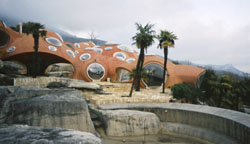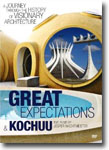 |
|
|||||||||||||||||||||||||||||||||||||||||||||||||||||||||||||
 There's a funny TED Talk video called "Lies, Damn Lies, and Statistics" about how to make a good - and a bad - TED Talk. One way to go bad is to talk about architecture. We may be safe in generalizing from TED to the general culture: architecture makes most people grow faint and causes their eyes to roll. There's a funny TED Talk video called "Lies, Damn Lies, and Statistics" about how to make a good - and a bad - TED Talk. One way to go bad is to talk about architecture. We may be safe in generalizing from TED to the general culture: architecture makes most people grow faint and causes their eyes to roll.Which is weird, because in and around architecture is where we engage with other people the most. Buildings great and small are pretty much exclusively where we conduct the four F's -- the two familiar ones, fight or flight, plus the two even more familiar ones that everybody forgets to put on the F-list: freeze (or space out) and fuck. Architecture is where we live all the fundamentals of, well, life. From coffee to water cooler to toilet to bed, we really, really need architecture to help house us. Architectural history and agendas ought to be taught in grade school. We ought to be taught to find beauty in a joist, or a good coat of insulation, for the simple reason that thinking about buildings and their interactions with people, other buildings and the rest of the world -- in other words, thinking about the ecology of construction -- is a good thing, like reading and writing and music and math. And if we knew more about how things went together, the costs involved (both economic and environmental), we might make smarter choices about the places we build to live and work in. It's possible architecture and construction were taught in ancient times, as part of the normal school that goes into growing an adult(ish) human. Birds learn it, bees learn it - humans can learn architecture, too. Indeed, the root of our word "poetry" is an ancient Greek one meaning the sometimes all-too-familiar action "to make" and, by association, the agent practicing the action, the "maker." But then, in the olden days, pigs knew how to make brick houses and wolves knew how to blow them down. So much we've lost. Now our concern is getting the kids to soccer in the minivan which, when you stop and examine the interior, is a lot like a house in some ways. In any case, we've gained a nice nugget of building wisdom and folly in Great Expectations Great Expectations It begins with the architecture of Rudolph Steiner, the Austrian founder of Anthroposophy, the Waldorf Schools and biodynamic farming. But Steiner was also an architect of incredible vision and imagination. In Dornach, Switzerland, there still stands a collection of homes built in the style of his Goetheanum, a building that pioneered the use of cast concrete in order to achieve an organic profile full of flowing lines and unexpected curves. In sharp contrast to Steiner, the mystical scientist was the Swiss architect and urban planner, Le Corbusier. Le Corbusier was a strict functionalist who dedicated himself to providing better living conditions for people dwelling in crowded cities. He's been criticized for creating "soulless monoliths." Indeed, his work inspired the city planners responsible for those urban train wrecks of the 1940s and later, suburban tract housing and low-income inner city "projects." With its philosophy of one-size-fits-all regardless of site and environment, the suburban tract home led the way to a general and widespread decline in the quality of American home building and tremendous waste of energy: most of the energy used by Americans goes to heat and cool their shoddy, leaky homes. There's great use of archival footage in Great Expectations The great sprawl began in Levittown, Pennsylvania, where, thanks to a production-line method of construction, a new home was finished every 16 minutes. The homes looked all the same, and when the men went to work, the self-contained town was emptied of cars and populated only by women - all about the same age - and their children. When the men came home from work, one interviewee tells us, they sometimes didn't remember precisely where their particular home was and so ended up sitting at the kitchen table of another man's home, waiting to be served dinner until he looked up and, like in the Talking Heads song, said "You are not my beautiful wife." Going deeper into functionalism, we visit the capital of Brazil, Brasília. Brasília was planned and developed in 1956. Lúcio Costa was the principal urban planner and Oscar Niemeyer the principal architect. One resident of the purpose-built city says that living there is like living in a "giant office." Like Washington, D.C., and Canberra, the capital of Australia, there is something desolate and inhuman about the wide, pedestrian-unfriendly streets and the sheer faces of the concrete office buildings. The film then flips a one-eighty, switching from the functional to the whimsical. Consider Pete Cook's zeppelin-borne cities descending on a rural village in order to provide residents with a brief urban experience. Cook says them some of his projects may look hi-tech, but the reality is that his budgets have never allowed such extravagance. Instead, he uses creativity and "crap tech." Moshe Safdie designed a village that was built on the water's edge in Montreal for the 1967 World's Fair. He had just discovered Legos, and his high-density apartment complex looks like it. This charming and humane complex is cleverly designed so that every apartment has a garden. Although Safdie's intent is clearly along the lines of Le Corbusier's, his designs are nothing like the monoliths that so influence urban planners in the mid-century. Like Safdie, who dodged symmetry and the overuse of right angles, Antti Lovag designs round-surfaced homes, asking, Where in nature do we see straight lines? So, too, with Peter Vetsch, whose beautiful sprayed-concrete homes are partially covered with earth, thus drastically reducing heating and cooling costs. Vetsch says innovation is inspired by disaster. If he's right, the next few decades should be truly inspiring. Two of my favorite moments in the film are visits to Florida and New Mexico. In the jungles of Florida, we meet Jacques Fresco and his partner in design, Roxanne Meadows. Fresco wants to move us toward a sustainable, resource-based economy. His utopian vision is truly off the hook but nonetheless charming. If, he says, we could increase productivity enough, we'd be rid of crime and greed because goods would be so plentiful that money would become meaningless. By Fresco's calculations, fewer than 7,000 workers are needed to run a global utopia. But for this to work, we have to do it "nature's way, not Fresco's way." Then there's a visionary with his feet on the ground: Paolo Soleri, the architect behind the community north of Phoenix, Arizona, called Acrosanti. Soleri coined the term "arcology," meaning architecture guided by ecological principals. Surely influenced by the Barcelona Modernistas such as Antoni Gaudi, Soleri's buildings are graceful curves that work with site and sun to become part of the landscape. Unlike the Venus Project, which is mostly models on a drawing table, Acrosanti is a living village famous for its intensely creative crafts people, a work in progress that welcomes tourists and kindred spirits. This DVD has another beautiful film as well, Kochuu Buildings are, after all, arcologies, even if we don't design them with their surrounding environment in mind. Nature bats last: count on that, and a building and its surroundings are a "kochuu": they are worlds "in-the-jar." These films are highly recommended for anyone beginning to contemplate the four walls around them (and, too, for anyone who is asking, Why four?) or for anyone looking to communicate the urgent need for critical thinking about architecture. |
|
|||||||||||||||||||||||||||||||||||||||||||||||||||||||||||||
|
||||||||||||||||||||||||||||||||||||||||||||||||||||||||||||||
| action | animation | art house/international | comedy | documentary | drama | family | horror/sci-fi | suspense | television | ||||||||||||||||||||||||||||||||||||||||||||||||||||||||||||||
| contact | home | ||||||||||||||||||||||||||||||||||||||||||||||||||||||||||||||


